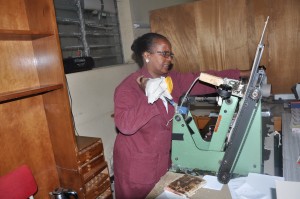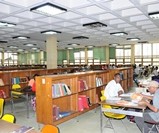Binding
Bookbinding is the process of physically assembling a book from an ordered stack of paper sheets that are folded together into sections or sometimes left as a stack of individual sheets. The stack is then bound together along one edge by either sewing with thread through the folds or by a layer of flexible adhesive. For protection, the bound stack is either wrapped in a flexible cover or attached to stiff boards. Finally, an attractive cover is adhered to the boards and a label with identifying information is attached to the covers along with additional decoration. Book artists or specialists in book decoration can greatly expand the previous explanation to include book like objects of visual art with high value and artistic merit of exceptional quality in addition to the book’s content of text and illustrations.
AAU Libraries has its own mechanism for the preservation and maintenance of its print materials. The Binding Unit which binds paperback books into hardcover for longevity, and periodicals in volumes also binds theses and undertakes repair and maintenance of damaged library materials.
 |
 |
 |
 |
 |
 |
Hard Binding
A hardcover, hardbound book has rigid covers and is stitched in the spine. Looking from the top of the spine, the book can be seen to consist of a number of signatures bound together.
Paperback binding
Though books are sold as hardcover or paperback, the actual binding of the pages is important to durability. Most paperbacks and some hard cover books have a “perfect binding”. The pages are aligned or cut together and glued. A strong and flexible layer, which may or may not be the glue itself, holds the book together. In the case of a paperback, the visible portion of the spine is part of this flexible layer.
Terms and techniques
Most of the following terms apply only with respect to binding practices:
- A leaf (often wrongly referred to as a folio) typically has two pages of text and/or images, front and back, in a finished book. The Latin for leaf is folium, therefore “folio” should be followed by a number to distinguish between recto and verso. Thus “folio 5r” means “on the recto of the leaf numbered 5”, although technically not accurate, it is normal to say “on folio 5r”. In everyday speech it is common to refer to “turning the pages of a book”, although it would be more accurate to say “turning the leaves of a book”; this is the origin of the phrase “to turn over a new leaf” i.e. to start on a fresh blank page.
- The recto side of a leaf faces left when the leaf is held straight up from the spine (in a paginated book this is usually an odd-numbered page).
- The verso side of a leaf faces right when the leaf is held straight up from the spine (in a paginated book this is usually an even-numbered page).
- A bifolium (often wrongly called a “bifolio”, “bi-folio”, or even “bifold”) is a single sheet folded in half to make two leaves. The plural is “bifolia”, not “bifolios”.
- A Section, sometimes called a gathering, or, especially if unprinted, a quire, is a group of bifolia nested together as a single unit. In a completed book, each quire is sewn through its fold. Depending of how many bifolia a quire is made of, it could be called:
- duernion – two bifolia, producing four leaves;
- ternion – three bifolia, producing six leaves;
- quaternion – four bifolia, producing eight leaves;
- quinternion – five bifolia, producing ten leaves;
- sextern or sexternion – six bifolia, producing twelve leaves.
- A codex is a series of one or more quires sewn through their folds, and linked together by the sewing thread.
- A signature, in the context of printed books, is a section that contains text. Though the term signature technically refers to the signature mark, traditionally a letter or number printed on the first leaf of a section in order to facilitate collation, the distinction is rarely made today.
- Folio, quarto, and so on may also refer to the size of the finished book, based on the size of sheet that an early paper maker could conveniently turn out with a manual press. Paper sizes could vary considerably, and the finished size was also affected by how the pages were trimmed, so the sizes given are rough values only.
- A folio volume is typically 15 in (38 cm) or more in height, the largest sort of regular book.
- A quarto volume is typically about 9 in (23 cm) by 12 in (30 cm), roughly the size of most modern magazines. A sheet folded in quarto (also 4to or 4º) is folded in half twice at right angles to make four leaves. Also called: eight-page signature.
- An octavo volume is typically about 5 to 6 in (13 to 15 cm) by 8 to 9 in (20 to 23 cm), the size of most modern digest megazines or trade paperbacks. A sheet folded in octavo (also 8vo or 8º) is folded in half 3 times to make 8 leaves. Also called: sixteen-page signature.
- A sextodecimo volume is about 4 1⁄2 in (11 cm) by 6 3⁄4 in (17 cm), the size of most mass market paperbacks. A sheet folded in sextodecimo (also 16mo or 16º) is folded in half 4 times to make 16 leaves. Also called: 32-page signature.
- Duodecimo or 12mo, 24mo, 32mo, and even 64mo are other possible sizes. Modern paper mills can produce very large sheets, so a modern printer will often print 64 or 128 pages on a single sheet.
- Trimming separates the leaves of the bound book. A sheet folded in quarto will have folds at the spine and also across the top, so the top folds must be trimmed away before the leaves can be turned. A quire folded in octavo or greater may also require that the other two sides be trimmed. Deckle edge, or Uncut books are untrimmed or incompletely trimmed, and may be of special interest to book collectors.


















